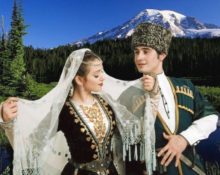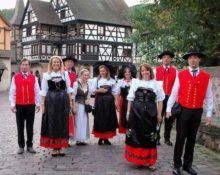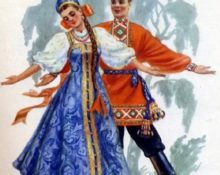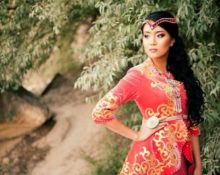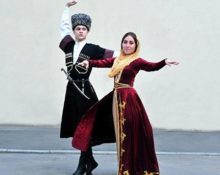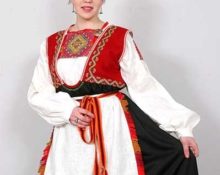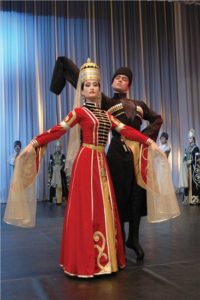 National costume is one of the important components of the culture of a particular people, telling about its customs and history of development. Many people may not know the details of the development of such unfamiliar countries as Scotland, but when they see a man dressed in a plaid skirt, the name “Scottish kilt” pops into the mind of almost everyone.
National costume is one of the important components of the culture of a particular people, telling about its customs and history of development. Many people may not know the details of the development of such unfamiliar countries as Scotland, but when they see a man dressed in a plaid skirt, the name “Scottish kilt” pops into the mind of almost everyone.
Women's and men's suits embroidered with gold can tell about one of the many nationalities of Russia living in the Caucasus, the Circassians, or as they are also called the Adygs. For their style of dressing, these people received the well-deserved title of “legislators of Caucasian fashion.”
Features of the Adyghe national costume
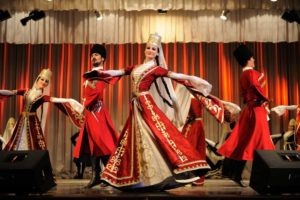
The Adygs demonstrated the final version of their costume at the end of the eighteenth century. Since then, it has had a common name - Adygafasha. Before this, as the results of excavations show, the Circassians decorated their clothes with gold and silver threads and sewed them from expensive and noble fabrics - velvet and silk.
A modern suit also cannot be called boring and monotonous; it is still decorated with patterns of gold and silver, and the preferred color of a woman’s outer dress is red.
Reference! Like most folk costumes, national Circassian clothing has a gender division. Men's clothing is called cherkeska, women's clothing is called sae.
Main features and types of women's Adyghe costume
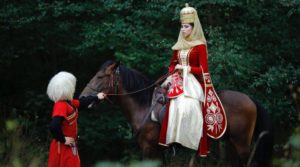
Women's national costume consists of several elements:
- Underwear shirt. A floor-length shirt, visible in the slits of the outerwear, was worn on a naked body; most often it was burgundy or yellow. Comfortable loose-fitting trousers were worn underneath;
- Kaftan. From the moment the Circassian woman reached puberty, over her shirt she began to wear a short caftan with a large number of silver fasteners on the chest. The color of the clothing was either red or black, and was decorated with gold embroidery along the edges of the sleeves and hems;
- Outer dress. The everyday dress was made from simple fabrics and embroidered with colored threads only along the edges of the hem and sleeves. There was a slit in the front of the dress, through which the caftan and its beautiful fasteners were visible. Festive dresses were made of silk or velvet and generously decorated with gold braid. The noblewoman's outfit was complemented by a belt with a large buckle;
- Headdress. Women did not always wear hats; their presence depended on age, social status and the event for which the outfit was selected. Little girls could go bareheaded until they were ripe for marriage and childbearing. Married women wore a velvet cap with elaborate intricate embroidery or braid. Depending on the number of children a woman had, the appearance of her hat was modified and supplemented with new details.
- Shoes. Circassian women wore either leather or morocco shoes on their feet. Women who were in the upper class wore prototypes of modern wedge shoes on their feet - boots with thick and high soles, cut to the shape of the feet and upholstered in expensive fabrics.
Main features and types of men's Adyghe costume
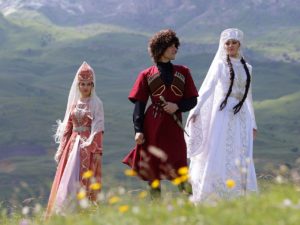
Men who took part in hostilities wore helmets, elbow pads, mittens and chain mail, which protected them in battle. Such armor was passed down from generation to generation, and today the surviving examples are museum exhibits.
The Circassian men's suit, like the women's, consists of several parts:
- Underwear shirt. A long shirt made of plain white fabric was worn over a naked body;
- Beshmet. Over the shirt, men wore a beshmet - a caftan with long and narrow sleeves, a stand-up collar and a clasp on the chest. Rich princes wore a beshmet made of light wool or silk in bright red or black. Peasant caftans were simpler - made of homespun cloth;
- Shtanov. The pants had a simple cut - the legs were connected to each other by a wedge and tightened with a thin belt at the waist;
- Cherkesski. The upper part of a man's suit was most often either gray or burgundy. The length of the first Circassian women was below the knees; later, depending on fashion, it was either shortened or became even longer. On the front of the Circassian coat there were pockets for gunpowder cartridges;
- Shoes. On their feet, men wore soft shoes - chuvyaki - over felt or leather leggings. The princes wore embroidered morocco shoes made of thin morocco.
Each of the Adyghe costumes that have survived to this day was sewn by hand. Girls were taught sewing and embroidery skills from an early age.Today, unfortunately, Circassians have practically forgotten how their ancestors dressed. National costumes are only occasionally used at holidays and special events dedicated to the history of the people. More often they can be seen in the photo.


 0
0